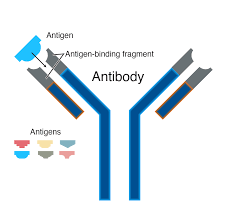
The fragment antigen-binding region (Fab region) is a region on an antibody that binds to antigens.
The Fab composed of one constant and one variable domain of each of the heavy and the light chain.
The variable domain contains the antigen-binding site, comprising a set of complementarity-determining regions.
Each arm of the Y thus binds an epitope on the antigen.
An antibody digested by papain yields three fragments: two Fab fragments and one Fc fragment.
An antibody digested by pepsin yields two fragments: a F(ab’)2 fragment and a pFc’ fragment.
The variable regions of the heavy and light chains can be fused together to form a single-chain variable fragment, which is only half the size of the Fab fragment, yet retains the original specificity of the parent immunoglobulin.
Fabs have therapeutic use in emergency medicine as an antidote: digoxin immune fab and Crofab, a mixture of Fabs for rattlesnake bites, against colchicine and tricyclic antidepressants.
Compared to whole antibodies, Fab’ and F(ab’)2 antibodies are less likely to trigger anaphylaxis, as the-related Fc region is removed
Fabs are a common form-factor for monoclonal antibodies designated for therapeutic use.
The Fab abciximab, which inhibits blood clotting, works by disabling glycoprotein IIb/IIIa found on platelets.
Ranibizumab, a treatment for macular degeneration, targets vascular endothelial growth factor A, a protein involved in the growth of blood vessels.
Certolizumab pegol is a Fab chemically linked to PEG, and it treats various inflammatory disorders by binding away TNFα.
Fab antibodies have diagnostic use: Arcitumomab is a mouse antibody that recognizes carcinoembryonic antigen, an antigen over-expressed in 95% of colorectal cancers.
Arcitumomab is conjugated to a radioactive element, which will label the tumors when viewed with single-photon emission computed tomography.
Sulesomab, an antigen that recognizes proteins on the surface of granulocytes, is used to label out infections, again using the 99mTc isotope.
